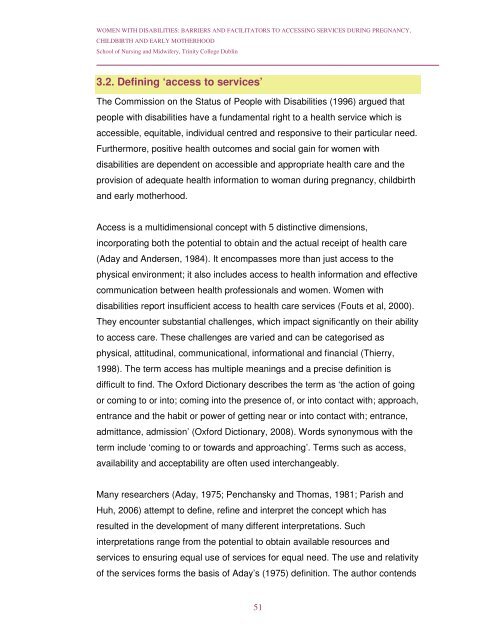Women with Disabilities: Barriers and Facilitators to Accessing ...
Women with Disabilities: Barriers and Facilitators to Accessing ...
Women with Disabilities: Barriers and Facilitators to Accessing ...
You also want an ePaper? Increase the reach of your titles
YUMPU automatically turns print PDFs into web optimized ePapers that Google loves.
WOMEN WITH DISABILITIES: BARRIERS AND FACILITATORS TO ACCESSING SERVICES DURING PREGNANCY,CHILDBIRTH AND EARLY MOTHERHOODSchool of Nursing <strong>and</strong> Midwifery, Trinity College Dublin3.2. Defining ‘access <strong>to</strong> services’The Commission on the Status of People <strong>with</strong> <strong>Disabilities</strong> (1996) argued thatpeople <strong>with</strong> disabilities have a fundamental right <strong>to</strong> a health service which isaccessible, equitable, individual centred <strong>and</strong> responsive <strong>to</strong> their particular need.Furthermore, positive health outcomes <strong>and</strong> social gain for women <strong>with</strong>disabilities are dependent on accessible <strong>and</strong> appropriate health care <strong>and</strong> theprovision of adequate health information <strong>to</strong> woman during pregnancy, childbirth<strong>and</strong> early motherhood.Access is a multidimensional concept <strong>with</strong> 5 distinctive dimensions,incorporating both the potential <strong>to</strong> obtain <strong>and</strong> the actual receipt of health care(Aday <strong>and</strong> Andersen, 1984). It encompasses more than just access <strong>to</strong> thephysical environment; it also includes access <strong>to</strong> health information <strong>and</strong> effectivecommunication between health professionals <strong>and</strong> women. <strong>Women</strong> <strong>with</strong>disabilities report insufficient access <strong>to</strong> health care services (Fouts et al, 2000).They encounter substantial challenges, which impact significantly on their ability<strong>to</strong> access care. These challenges are varied <strong>and</strong> can be categorised asphysical, attitudinal, communicational, informational <strong>and</strong> financial (Thierry,1998). The term access has multiple meanings <strong>and</strong> a precise definition isdifficult <strong>to</strong> find. The Oxford Dictionary describes the term as ‘the action of goingor coming <strong>to</strong> or in<strong>to</strong>; coming in<strong>to</strong> the presence of, or in<strong>to</strong> contact <strong>with</strong>; approach,entrance <strong>and</strong> the habit or power of getting near or in<strong>to</strong> contact <strong>with</strong>; entrance,admittance, admission’ (Oxford Dictionary, 2008). Words synonymous <strong>with</strong> theterm include ‘coming <strong>to</strong> or <strong>to</strong>wards <strong>and</strong> approaching’. Terms such as access,availability <strong>and</strong> acceptability are often used interchangeably.Many researchers (Aday, 1975; Penchansky <strong>and</strong> Thomas, 1981; Parish <strong>and</strong>Huh, 2006) attempt <strong>to</strong> define, refine <strong>and</strong> interpret the concept which hasresulted in the development of many different interpretations. Suchinterpretations range from the potential <strong>to</strong> obtain available resources <strong>and</strong>services <strong>to</strong> ensuring equal use of services for equal need. The use <strong>and</strong> relativityof the services forms the basis of Aday’s (1975) definition. The author contends51
















